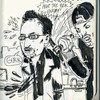If you’re like me, you have no idea what’s going on in the above YouTube clip. Six minutes of a pretty blonde woman who goes by GentleWhispering and looks like every kid’s favourite babysitter whispering to the camera in a light Eastern European accent and caressing it occasionally. It’s a little unsettling, almost like finding someone’s video diary and knowing immediately you weren’t supposed to watch it, and the tag “ASMR” doesn’t explain much, least of all why it has 125,000 views and more than 800 likes.
Annons
Annons
Maria, aka GentleWhispering (she didn’t want me to use her last name), has been triggered by everything from accented whispers to being tickled when she was in kindergarten. During a Skype conversation I had with her, she described ASMR as feeling like “bubbles in your head”, and compared it to getting a scalp massage, but the sensation is on the inside. She went on: “It’s like a little explosion, and then just little sparkles and little stars going down [your back]. Depending on the strength of the trigger, it might just go into the top of the spine of the shoulders, but sometimes it goes down to your arms and legs and other parts. Mostly, if you get it in your leg, it’s really exciting!”Maria is the reigning queen of the ASMR videos, with over 34,000 subscribers to her channel and 12 million views. She mostly speaks directly at the camera in her accented English, giving a Russian language lesson or pretending to be a physical therapist.She makes a “slight income” from her channel views, but told me she feels guilty about it (“I’m not doing it for money, but I still get it”) and puts most of it back into her videos. She recently bought a 3D microphone, a key accessory for any ASMR video maker; it makes those fake haircuts feel so much more real – put on some headphones and you can hear the scissors snip around your ear while she makes small talk in the other.
Each video takes seven to ten takes for her to get right, and that’s after coming up with an idea, the props she wants to use and a script. And she watches her previous videos to refine her technique – she says she isn’t triggered by her own work, but can feel the moments that would trigger other people.
Annons
Everyone has probably had the experience of falling into a trance at the drone of a teacher’s voice, or getting some pleasure from stroking his or her hands through a dog’s coarse fur, but ASMR seems to be much stronger than that. It’s hard to be more definite than,“This feeling sure is, um, something, and man people like those videos!” because there have been no official scientific studies on ASMR. When someone created a Wikipedia page for it, it was promptly struck down by sceptical Wiki editors who said the article “lacked scientific evidence”. (Don’t worry, the list of chess openings named after animals is still there.)
Annons
Back in 2008, a Yahoo! group called the Society of Sensationalists formed, with a somewhat vague manifesto: “All we have right now are questions and we need answers. We need help, not in the sense that we want to solve or cure this sensation but rather instead to learn what causes this.” People would find their way to these forum discussions by desperate internet searches for “weird head feeling” or “head tingles”, but the discussion remained confined to the forums until 2010, when Andrew MacMuiris started a blog called The Unnamed Feeling to work through the same questions all ASMRers were asking, such as, “What the hell is this?” and “Why does it happen to me?” and “Does it happen to you, too?”
Annons
But what is it? That’s a trickier question, and one asked all over the ASMR-centric parts of the internet all the time. Some describe the brain tingles as a form of enlightenment. One member of the most popular ASMR Facebook group posited that animals experience ASMR-like sensations when they groom each other. Others have theorised that there’s a link between ASMR and Synesthesia (another little-understood mental phenomenon), while Karissa Ann Burgess, who is in charge of experimental research and data for asmr-research.org, told me she thought that ASMR was caused by “secretions from the pineal gland” in the brain, which is regarded as a “third eye” or even the soul by some people who believe in things like third eyes and souls. I even heard from Shaun Robertson, who doesn’t experience ASMR but was involved in the community for a time, that a few people believed that the condition was “the next stage of human consciousness.”
Annons
